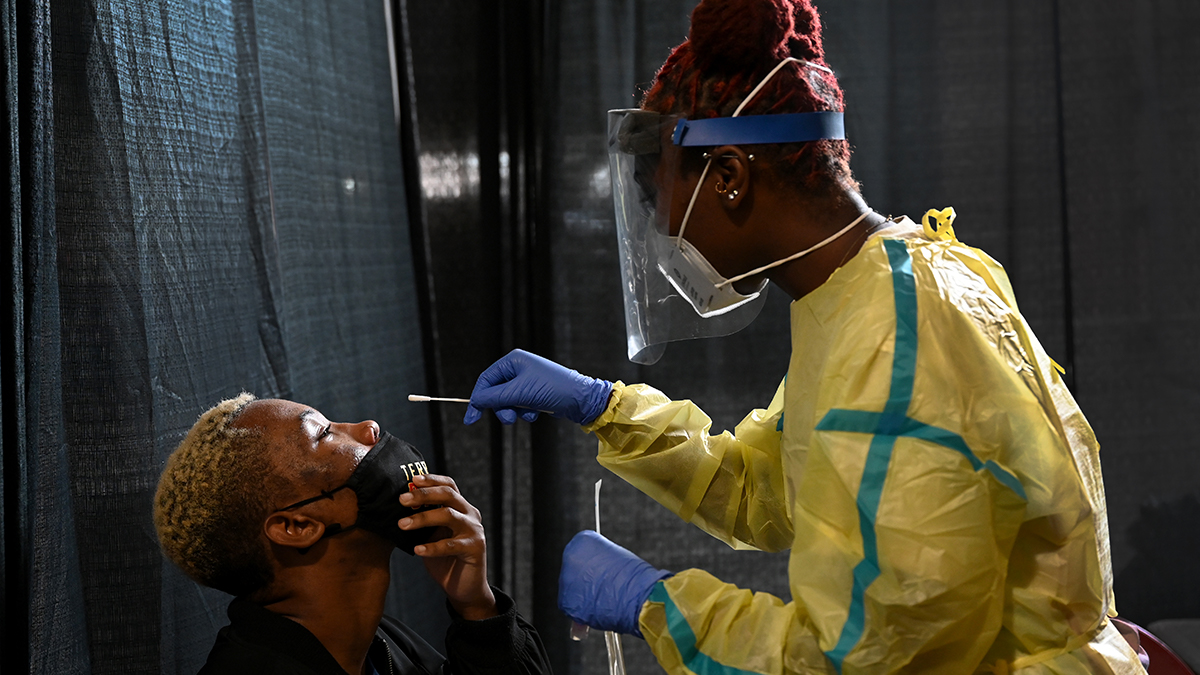Vaccinating the U.S. population against COVID-19 is going slower than officials had hoped for. Fewer than 5 million doses have been given out, a fraction of the 20 million shots the Trump administration promised by the end of last week.
“The idea that the vast majority of vaccines we have produced are sitting in freezers across the country and not getting into people’s arms is a crisis,” said Dr. Ashish Jha.
We're making it easier for you to find stories that matter with our new newsletter — The 4Front. Sign up here and get news that is important for you to your inbox.
Federal officials insist the pace for administering the shots is picking up.
Moderna said it will increase vaccine production by 20% with the U.S. securing 100 million doses by the end of March and another 100 million by June.
Virginia now has almost enough vaccine doses to cover its first group, 1A, which includes healthcare workers, long term care facilities and first responders.
But it's still taking a long time to administer those doses.
Most of the shots have been given in Northern Virginia, where officials say there’s a high concentration of health care workers and hospitals.
The state is unsure when it will begin giving shots to the next group. Officials are still trying to decide which essential workers will be eligible for the next wave of vaccinations.
The District has announced new details on when residents could start receiving vaccines.
The goal is to begin vaccinating residents 65 and older over the next few weeks. Then, on Jan. 25, other essential workers. Starting Feb. 1, people with chronic medical conditions are set to become eligible.
Despite rising case numbers, Fairfax County's school board will discuss plans to get kids back in the classroom.
Right now, the proposal is to start the phased return of hybrid learning for all willing students between Jan. 12 and Feb. 2.
The return to the classroom will be done in groups and will be based on local health metrics.
What the Data Shows
Coronavirus cases continue to rise in the region, with Virginia showing the worst signs. Although more than 100,000 Virginians have received their first dose of COVID-19 vaccine, the state’s positivity rate shows that infections are surging at a concerning rate.
At 16.2% Virginia’s positivity rate is alarmingly high – that’s just four percentage points lower than the state’s all-time high back in April.
Maryland’s positivity rate is at 9.19%, the highest level reached since May.
D.C.’s daily case rate is still in the red zone, with 31.77 cases per 100,000 people on average. The seven-day average positivity rate is also high at 6.6%.
D.C. reported 262 new coronavirus cases and four additional lives lost on Tuesday. Maryland had 1,956 new cases and 54 deaths. Virginia recorded 3,042 new confirmed infections and 50 deaths.
Seven-day averages increased everywhere in the D.C. region. The average in D.C. rose 10 cases to 233 Tuesday. Maryland’s average rose by 11 cases to 2,671 in Maryland. In Virginia, the seven-day average is at 3,206, an all-time high.
The number of hospitalized patients with confirmed coronavirus infections in Virginia jumped by nearly 200 in 24 hours. There are currently 2,608 Virginians hospitalized, a new record for the state.
Hospitalizations also increased in D.C. (now at 260) and Maryland (now at 1,771).
Vaccinations in the region are up to nearly 200,000 as of Tuesday. Local vaccine portals indicate that recipients are still receiving their first doses, and no second doses have been administered yet.
Local Coronavirus Headlines
- D.C. residents age 65 and older, teachers and several categories of essential workers will be able to make appointments this month to receive a COVID-19 vaccine, officials say.
- More than 1,400 long-term care facilities in Virginia are expected to receive doses of the coronavirus vaccine in the coming weeks.
- Two D.C. friends got a lucky break while in Giant Food in Washington, D.C.,: When someone didn't show up for their vaccination appointment, the pharmacist asked him and his friend if they wanted to get the Moderna shot.
- Virginia reported another record day for new coronavirus infections, and that surge is putting even more pressure on hospitals in the commonwealth already pushed to the brink.
- Among the industries hit hardest by the pandemic has been performance venues like theaters and nightclubs, but help is on the way after President Donald Trump signed the new relief bill.
- New figures from the Virginia Department of Corrections show that two inmates and one staff member who tested positive for the coronavirus have died in recent days.
- The high level of coronavirus cases is putting stress on Northern Virginia hospitals — and the health care professionals who work there.
- The stress of the pandemic is a grind. A data analysis from the American Dental Association shows a surge in cases of teeth grinding, clenching and cracking during the COVID-19 crisis. The increases are striking and potentially costly and painful for sufferers.
- A professor is using the trust Black Americans have in barbers to make them more comfortable with taking the COVID-19 vaccine.
- A rapid antigen test might seem like a great idea when you're in a hurry and don't have time to wait a few days for results, but those tests are really designed for people with COVID-19 symptoms and in asymptomatic patients can deliver false positive results.
- Maryland Gov. Larry Hogan announced measures to boost the number of available health care workers and plan for more hospital beds.
- COVID-19 numbers continue to paint a dire picture for Black Americans, and there is an ongoing effort in the Black community to increase testing.
Reopening Tracker
- A judge upheld Montgomery County, Maryland's ban on indoor dining.
- D.C. has suspended indoor dining until 5 a.m. on Jan. 15, Mayor Muriel Bowser said in a press release.
- Virginia instituted a curfew and a stricter mask mandate.
- Maryland tightened restrictions on businesses, bars and restaurants.
- All Smithsonian museums and the National Zoo are closed because of rising COVID-19 cases.
- Hours before some Fairfax County students were set to return to in-person learning, the school district said that they needed to delay the plan.
- Courts throughout Maryland remain partially shut down due to the pandemic.
- Prince George's County tightened restrictions and required masks to be worn outdoors.
How to Stay Safe
Anyone can get COVID-19. Here are three simple ways the CDC says you can lower your risk:
- Wear a snug-fitting mask that covers your nose and mouth.
- Avoid being indoors with people who are not members of your household. The more people you are in contact with, the more likely you are to be exposed to COVID-19. If you are indoors with people you don’t live with, stay at least six feet apart and keep your mask on.
- Wash your hands often, especially after you have been in a public place.



